Tonga & Fiji Flora
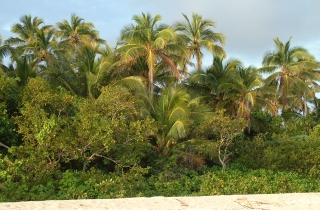
Coconut palms stand tall above the coastal
vegetation in the South Pacific Islands |
The quintessential South Pacific tree is the Coconut Palm Cocos nucifera.
Standing up to 30m (100 ft) tall, they are often the first
sign of land when one approaches from the sea. Believed to have originated in Polynesia
(although some authorities say South America) this
valuable plant has many hundreds of uses and could be called the "tree of life"
of the South Pacific and the coastal tropics in general. Coconut palms are very
salt-tolerant and their nuts can float many thousands of miles and remain
viable. The trees live over 100 years and produce
50 to 80 fruits per year.
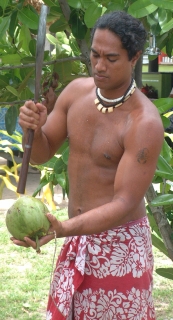
Ringa, a native of Rotuma (Polynesian Fiji) whacks open a green drinking nut |
In both Fiji and Tonga the coconut's outer husk is used for matting, fuel and
utensils, the trunk for timber and furniture making, and the leaves for
thatching. When the nuts are young the clear coconut water makes a
refreshing drink. We know that in Southeast Asia this water is fermented or distilled
to produce alcoholic beverages, but we didn't see evidence of that in Tonga or
Fiji. The sweet white "meat" (what most of us in the West think of as coconut)
is eaten as is, or grated and used in cooking. A thick white milk squeezed from
the fresh coconut meat is used in curries and fish dishes. Drinks such as piña
coladas have made it onto the bar drinks list of many Fijian resorts. There's
nothing like the refreshing taste of fresh coconut cream, pineapple juice and rum!
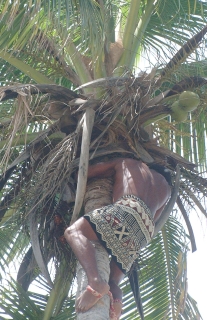
Ziggy showing his stuff |
At Robinson Crusoe Island, in Fiji, we had a great demonstration of coconut tree
climbing. Ziggy, a muscular young Fijian, wrapped a rag around his ankles to
keep his feet together, then proceeded to hop up a very vertical, very tall
coconut palm from which he harvested the nuts. But there is a technique to
it - a tourist saw the demonstration and tried to emulate Ziggy, removing much
of the skin from the soles of his feet.
Commercially, the coconut is used to produce copra. Copra is the name
for the dried white “meat” which can be seen laid out in the sun in villages in both
Tonga and Fiji. Once dried, the copra is shipped in burlap bags to processing
plants (of which there are surprisingly few) such as the one in Savusavu, Fiji,
where the copra is shredded and pressed for its oil. The coconut oil is sold for
use in cosmetics, soaps, cooking oil and margarine. Copra, which is about 65%
oil, is a staple commercial crop of much of the South Pacific. It is
used in cosmetics, cooking oil and margarine.
On top of all that, the trees are beautiful, with their branchless trunks
and flowing tufts of leaves dotted with green and yellow nuts.
| The beaches of Fiji and Tonga are often adorned with the large, almost
circular-leaved creeping vine: Beach Morning Glory Ipomoea pes-caprae.
Reaching lengths of over 30 feet (10m), the vines descend from above the high tide
line to near the water’s edge and bear lovely pink or purple trumpet-shaped
flowers. The seeds can germinate and grow in seawater, allowing this plant to
flourish on beaches around the world. The Latin name pes-caprae, meaning
goat’s foot, describes the shape of the leaves with their circular shape and
notched apex. |
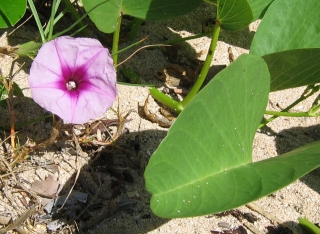 |
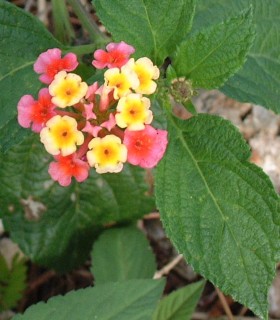 |
Sprawling, often prickly shrubs of fragrant and colorful lantana Lantana sp.
(Verbena family) line the roadsides and yards of Tongan and Fijian homes.
Originally from South America and the US southern states, this aromatic plant is
now common as an ornamental throughout most of the tropics, and is naturalized
in parts of SE Asia where it forms dense thickets. Flower color can vary from
plant to plant and throughout the flowering season on the same plant. The leaves
are aromatic and can be used for medicinal purposes. |
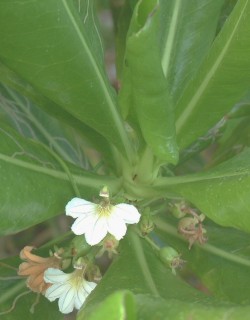 |
These two plants are commonly found on the seashores of Tonga and Fiji.
We don't know much about them, just their names:
Scaevola (left) and Beach Heliotrope (right).
Both were photographed on a beach in the Ha'apai Group of Tonga. |
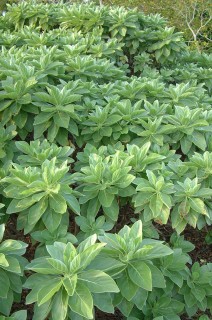 |
| The Flamboyant Delonix regia, is a native of Madagascar, but
is now common throughout the tropics as an ornamental tree. With its
broad, umbrella-shaped crown, this tree is often planted for shade along
streets and in public gardens. The scarlet flowers bloom in spring. The
leaves fold up quickly at dusk and are shed in the dry season. The tree, which reaches
10 to 15 meters (30‑45 ft) has many long brown pods, either wrinkled
or flat when ripe, can grow to about 60 cm (2 feet) long. Also known as the
Flame Tree or Royal Poinciana, this is the national flower of Puerto
Rico. And here we photographed it half-way around the world, in Fiji! |
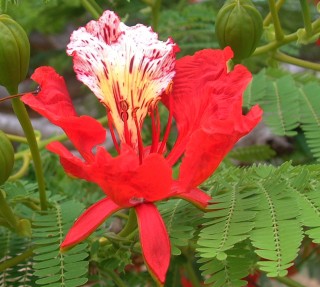 |
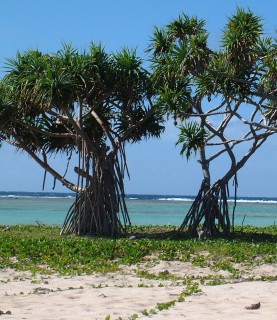 |
Appearing like something from a Dr. Seuss book, the Screw Pine or Screw Palm
Pandanus spp. grows like multi-legged creatures on sandy beaches and
spray-covered cliffs in Tonga and into the hills of Fiji. So named for
the spiral arrangement of its leaves, Pandanus are also identified by the sharply
toothed long leaves, and the several meters’ long roots that extend from the
base of the trunk. A large, polyhedron-shaped fruit the size of a human head is
found in older plants, and is eaten by some South Pacific islanders. The tough
leaves can be made into woven mats, baskets and hut coverings. On many islands
without forests, the pandanus wood is used to build houses. |
| On the coast of Tonga a very common tree is the Casuarina Pine, also called
Horse-Casuarina, and South Sea Ironwood Casuarina equisetifolia. This
lovely tree graces most of the coast line of Tonga, its fine filigree of
branches with tightly whorled leaves (like pine needles) wafting in the breeze.
It reaches over 20 m in height and is salt tolerant and quick growing. The trees
are not true pines, and have none of the familiar scent of pine trees. It comes
originally from Australia, Indonesia and Africa. In New Caledonia and
Australia alone there are over 50 species. |
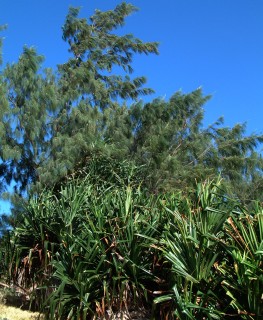 |
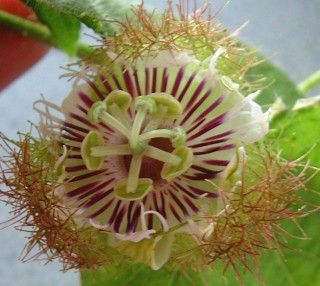 |
Passion-fruit Passiflora spp. with 400
species can be found throughout the tropics, some originating in the New World,
with a few species from Asia, Australia and the Pacific. The intricate flower of
the passion fruit vine is so named for its visual representation of
Christian symbols. We're not botanists, and
don’t know what we found, but it was definitely a passion fruit flower, with its
striking arrangement of petals, stamen, and ovaries. All passion fruits are
vines, and some produce delicious edible fruits. A single plant can produce over
100 fruits in a year, and the vines intertwine to form canopies. Known in the
South Africa as granadilla, it is known in South America and the French islands as
maracuja. |
| An old friend from the Caribbean is the Frangipani
Plumeria spp. which was long ago brought by missionaries to the South
Pacific. Not as profuse as in the Caribbean, the trees are
nonetheless common and still sport the lovely fragrant blossoms of
yellow or pink which are formed in the shape of the blades of a fan. The
branches, which are very regular in their branching are thick and smooth
and exude lots of latex if broken. |
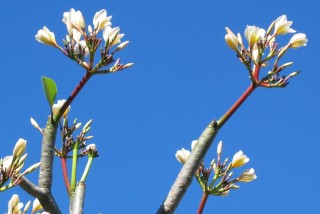 |
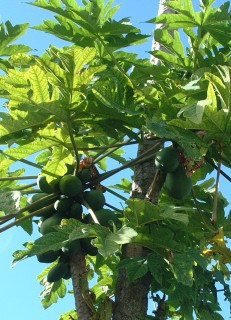 |
Another migrant from South America is the Papaya
Carica papaya, brought to Asia and the south Pacific in the 1800’s.
These short-lived trees, standing no more than 18 to 20 feet (5‑6m)
high, are found throughout the islands, both on plantations and singly beside
homes. Bearing fruits year round they provide a staple fruit and may be
either bright yellow or reddish orange inside a yellow-green skin. In
Tonga and Fiji papayas in the markets tend to be small (about the size
of an oval-shaped grapefruit) and sold in bunches of 4‑6 for about
50 cents US. The large football sized fruits that were common in the
Caribbean are not common in the western Pacific. Papayas can be eaten
baked and stuffed when green, or with a squeeze of lime when ripe. |
Common in the markets of both Tonga and Fiji are small,
sweet pineapples, a variety of bananas and plantain
(cooking bananas), mangos (in season), and pumpkin. Okra,
which originated in Asia, is a staple of the Fijian diet and commonplace in the
markets. Root crops such as taro, sweet potato, and cassava
are also staples, predominantly grown in small family plots, and sold by
individuals at the open air markets.
| In Fiji, the western ends of the two largest islands, Viti
Levu and Vanua Levu, are agricultural centers for Sugar Cane Saccharum
officinarum. Hundreds of kilometers of narrow-gauge railway bring cut cane
to the mills in Lautoka, Ba, and Labasa during the winter months of June through
November, and the air is filled with soot from the mills and from the burning
fields. The plants originated in Asia, probably in New Guinea and have spread
around the tropical world. Sugar cane is a grass-like plant, standing about 15 to
20 feet (4‑6m) high when mature. Most cane is grown for less than one year before
harvest. The cut cane is crushed between rollers to extract the sugar juice, and both
molasses and raw sugar are exported from Fiji. |
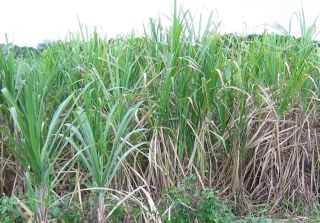 |
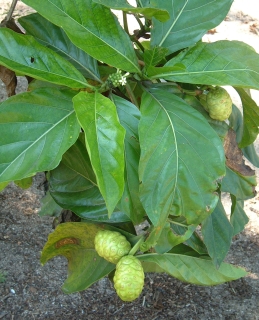 |
The Fijians have long known of the curative properties
of the Noni Fruit. This large-leaved tree with its knobbly
green fruits is commercially grown in the Society Islands of French
Polynesia and is found in the wild throughout Fiji. A juice made from
the fruit is used to reduce arthritis inflammation, joint pain and
general health. The Fijians warm the leaves over a flame then place them
on boils to extract the infection. In Fijian, the name of the Noni plant
is Kura. |
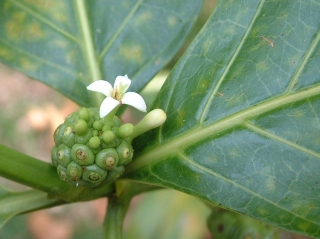 |
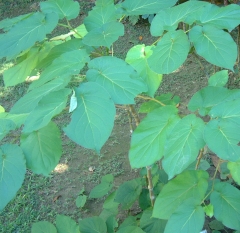
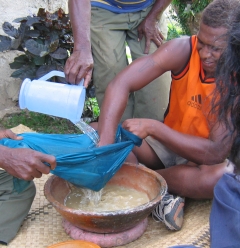 No discussion of the plants of the western Pacific
would be complete without mention of the omnipresent Yaqona or kava plant
Piper methysticum. Endemic to Polynesia and Melanesia, the root of this
pepper plant is ground into a fine white powder with mortar and pestle, mixed with water,
filtered through a cloth and drunk by
Tongans and Fijians, often to excess. Originally a drink for the village chiefs,
it is now used as a mild narcotic and social drink by male children as young as
12 or 14. Every Fijian and Tongan party serves kava in a large wooden 'tanoa' or
plastic bowl and the partying goes on until the kava bowl is empty. It is also
served at “grog” houses in Tonga and Fiji. It is traditional to offer a bundle
of yagona roots to the chief of a Fijian village when first arriving. If the
chief accepts the roots in this sevusevu ceremony he offers protection
and hospitality to the visitor. Drinking kava, which tastes like earthy water,
produces a mild numbness to the lips and mouth and can be quite soporific. The
plants are spindly, ungainly shrubs, reaching a few meters high, and can be seen
all along the roadways and homes in the Fijian countryside. It takes four years
for the plant to reach harvestable size.
No discussion of the plants of the western Pacific
would be complete without mention of the omnipresent Yaqona or kava plant
Piper methysticum. Endemic to Polynesia and Melanesia, the root of this
pepper plant is ground into a fine white powder with mortar and pestle, mixed with water,
filtered through a cloth and drunk by
Tongans and Fijians, often to excess. Originally a drink for the village chiefs,
it is now used as a mild narcotic and social drink by male children as young as
12 or 14. Every Fijian and Tongan party serves kava in a large wooden 'tanoa' or
plastic bowl and the partying goes on until the kava bowl is empty. It is also
served at “grog” houses in Tonga and Fiji. It is traditional to offer a bundle
of yagona roots to the chief of a Fijian village when first arriving. If the
chief accepts the roots in this sevusevu ceremony he offers protection
and hospitality to the visitor. Drinking kava, which tastes like earthy water,
produces a mild numbness to the lips and mouth and can be quite soporific. The
plants are spindly, ungainly shrubs, reaching a few meters high, and can be seen
all along the roadways and homes in the Fijian countryside. It takes four years
for the plant to reach harvestable size.
Up | Tonga & Fiji Flora | Tonga & Fiji Fauna | Tonga & Fiji Birds
Tonga Home
| Tonga Newsletters
| Tonga Diving
| Tonga Cruising Info
| Fiji Home
| Fiji Newsletters
| Fiji Diving
| Fiji Cruising Info
West Indies Flora/Fauna | Venezuela Flora/Fauna | SW Caribbean Flora/Fauna | Galapagos Flora/Fauna | Fr. Polynesia Flora/Fauna | Tonga & Fiji Flora/Fauna | Australia Flora/Fauna | Southeast Asia Flora/Fauna | Sri Lanka Flora/Fauna | Madagascar Flora/Fauna | Marine Mammals
Top Level:
Home |
Destinations |
Cruising Info |
Underwater |
Boat Guests |
Ocelot |
Sue |
Jon |
Amanda |
Chris |
Site Map |
Make a Comment
 |
Lifetime
Commodores
of the
Seven Seas
Cruising
Association |
 |
|
If our information is useful,
you can help by making a donation
|
Copyright © 2000‑ Contact:
Jon and Sue Hacking -- HackingFamily.com, svOcelot.com.
All rights reserved.





 No discussion of the plants of the western Pacific
would be complete without mention of the omnipresent Yaqona or kava plant
Piper methysticum. Endemic to Polynesia and Melanesia, the root of this
pepper plant is ground into a fine white powder with mortar and pestle, mixed with water,
filtered through a cloth and drunk by
Tongans and Fijians, often to excess. Originally a drink for the village chiefs,
it is now used as a mild narcotic and social drink by male children as young as
12 or 14. Every Fijian and Tongan party serves kava in a large wooden 'tanoa' or
plastic bowl and the partying goes on until the kava bowl is empty. It is also
served at “grog” houses in Tonga and Fiji. It is traditional to offer a bundle
of yagona roots to the chief of a Fijian village when first arriving. If the
chief accepts the roots in this sevusevu ceremony he offers protection
and hospitality to the visitor. Drinking kava, which tastes like earthy water,
produces a mild numbness to the lips and mouth and can be quite soporific. The
plants are spindly, ungainly shrubs, reaching a few meters high, and can be seen
all along the roadways and homes in the Fijian countryside. It takes four years
for the plant to reach harvestable size.
No discussion of the plants of the western Pacific
would be complete without mention of the omnipresent Yaqona or kava plant
Piper methysticum. Endemic to Polynesia and Melanesia, the root of this
pepper plant is ground into a fine white powder with mortar and pestle, mixed with water,
filtered through a cloth and drunk by
Tongans and Fijians, often to excess. Originally a drink for the village chiefs,
it is now used as a mild narcotic and social drink by male children as young as
12 or 14. Every Fijian and Tongan party serves kava in a large wooden 'tanoa' or
plastic bowl and the partying goes on until the kava bowl is empty. It is also
served at “grog” houses in Tonga and Fiji. It is traditional to offer a bundle
of yagona roots to the chief of a Fijian village when first arriving. If the
chief accepts the roots in this sevusevu ceremony he offers protection
and hospitality to the visitor. Drinking kava, which tastes like earthy water,
produces a mild numbness to the lips and mouth and can be quite soporific. The
plants are spindly, ungainly shrubs, reaching a few meters high, and can be seen
all along the roadways and homes in the Fijian countryside. It takes four years
for the plant to reach harvestable size.